Drones could save businesses big money by doing dull, dirty, and dangerous jobs much better than humans or helicopters. The problem is that drones can be difficult to program and pilot. Airware is out to change that with today’s launch of its Aerial Information Platform. Commercial businesses can now license Airware’s Flight Core autopilot technology, Ground Control Station for dispatching drones, and its cloud platform for customizing missions and collecting data.
With well over $40 million in funding from Andreessen Horowitz and Kleiner Perkins, the four year-old Airware is perhaps Silicon Valley’s premier drone startup. Airware’s integrated hardware, software, and cloud system lets enterprises customize drones to check on gas pipelines, survey farm land, inspect cell towers, patrol property, or do search & rescue,
Now we’ll see just how many businesses will pay a monthly subscription for Airware to power their drones for industrial inspections, agriculture management, anti-poaching, and more.
Consumer drone makers are growing fast as quad-copters become the hot new toy for kids and adults alike. China’s DJI is said to be raising money at a $10 billion valuation. But long-term, they’ll likely be commoditized as hardware makers around the globe clone and undercut each other on price.
It’s the way drones improve efficiency for heavy industry that could be the enduring money-maker. Whatever companies makes the software that runs these drones ould make serious profits for years to come.
Take To The Skies
Earlier this week, Airware bussed investors, customers, and a handful of reporters from San Francisco to an isolated farm in Petaluma, where the startup showed off its platform with a variety of drones built for different use cases. The company hoped to demonstrate how its system can be customized to let any drone do any job.
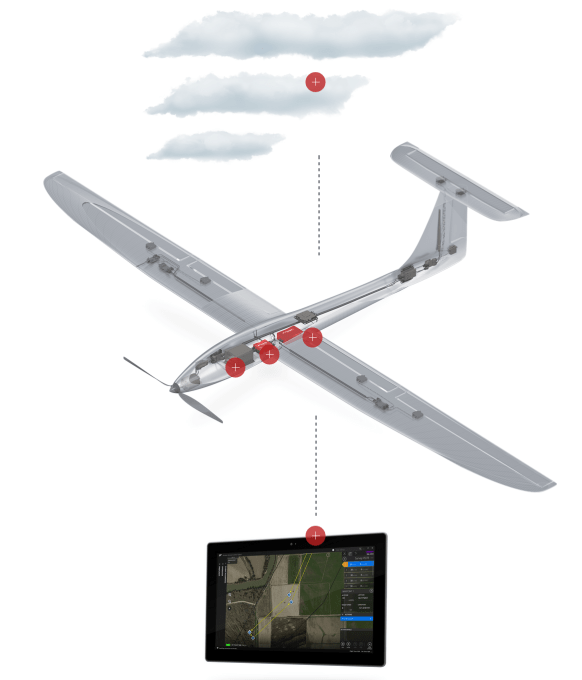
Following a brief introduction by Airware CEO Jonathan Downey, CTO Buddy Michini demonstrated Airware’s core technologies: the Flight Core autopilot system, which provides the brains to each drone that Airware powers, the Ground Control Station that lets a single user operate a fleet of drones from a Windows laptop or tablet, and a cloud platform that lets companies manage the various jobs to be done in the field and ensure they’re complying with flight regulations.
Rather than having to pre-program a drone, manually pilot it, and then painstakingly dump the data back to your servers, Airware can handle the whole process. The goal is to reduce the drone piloting expertise needed to get complicated missions flown.
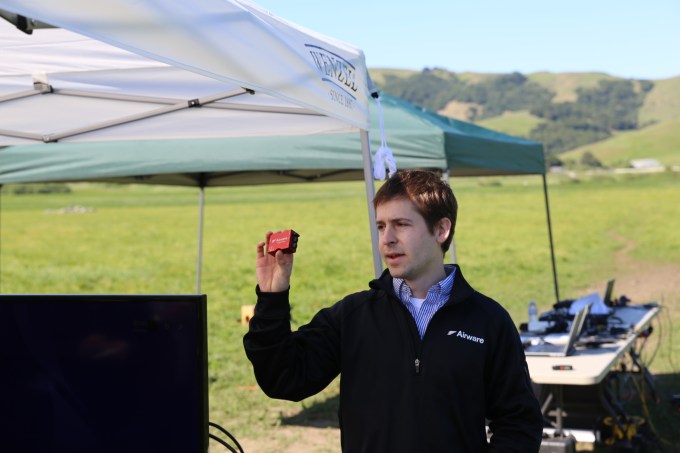
Airware CTO Buddy Michini shows off the Flight Core, the brains Airware puts in drones
Drone operators just set up the standard Airware control system, enhance it with cloud widgets to customize their drone to the day’s use case, and the data flows back automatically. Operators can just trace a flight path on a map instead of driving the drone in real-time.
After explaining what was happening behind the scenes, the startup had several of its biggest customers speak about their use of the platform in their own drones.
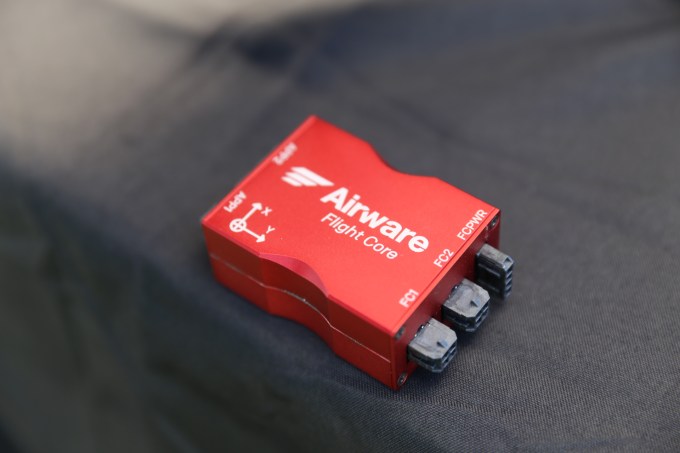
French drone company Delta Drone showed of its drone’s capabilities for surveying farmland and dig sites using flight plans generated Airware’s Ground Control Station. Users simply draw out a geofence for the drone to stay within and give it parameters like required altitude. It wasn’t the flashiest demo we’ve ever seen with a drone — after taking off, it went to a set height and stayed there, essentially patrolling the region defined in the app, moving back and forth along the field like a lawn mower, pushing slightly farther away with each pass.
But commercial drone use isn’t supposed to be sexy. It’s supposed to get the job done safe, fast, and cheap.
After several similar demos, Drone America CEO Mike Richards spoke about using his company’s larger drones with Airware’s software for missions outside of traditional industrial uses. One use case that could save lives: replacing lifeguards at beaches with drones carrying floatation devices that can identify people in distress.
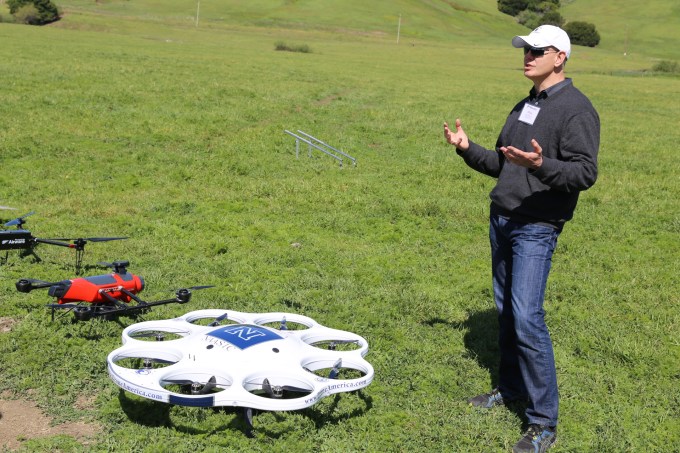
Drone America President and CEO Mike Richards
One of the new things shown off during these demos was support for fixed-wing drones, which can cover regions of roughly 1,000 square acres rather than the 100 acres a quadcopter can handle. It was easily the most exciting flight of the day, launching via a catapult, flying several quick passes around the the whole area, and landing with a couple of bounces on the thick grass.
After several more investors and customers spoke about their reasons for backing the company, the group broke out into discussions. During this time, Michini explained Airware’s plug-in system, which lets customers create widgets for the Ground Control Station in the C# programming language.
These widgets are actually the main reason Airware is sticking with Windows for its tablet app. Instead of requiring customers to build their own app with the exact drone interface needed, building on Windows will allow them to download the same app to each tablet but provide different interfaces by simply checking off which widgets should be available to different workers in the field on the cloud backend.
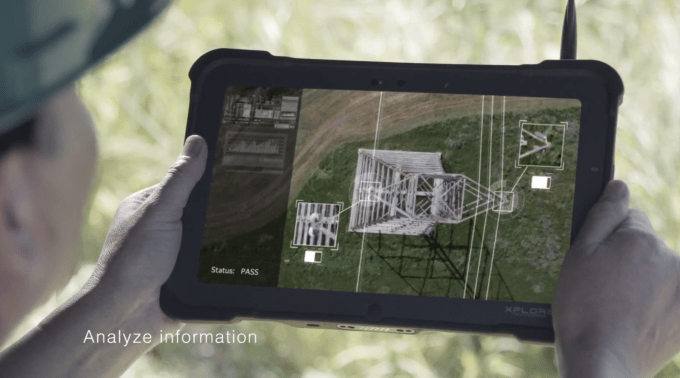
Michini was also excited to talk about the App Core, which will provide a full-on Linux computer for developers to work with in addition to the standard Flight Core autopilot and Ground Control Station integration. When it rolls out to select Airware partners this summer, this new system will let customers take advantage of more advanced sensor and image processing tools without sacrificing an interface that’s actually usable for operators in the field. Essentially, third-parties will be able to develop plug-ins to let drones handle even more niche missions.
Little Copters, Big Business
This is when Downey joined in and the subject shifted to business. Downey told TechCrunch that every customer starts on a paid basis — since they’re mostly industrial or “enterprise” clients who already have their own drones, there’s no need to offer a free tier just yet — and because these customers pay a subscription, Airware can roll out new products like App Core without having to find new companies to sell to or upsell its current customers.
Airware costs $2500 per drone per year. But the company doesn’t have to race to revenue just yet. It’s just added investment from Intel capital to the money from GE, A16Z, Kleiner, First Round, Google Ventures, and other prestigious funds.
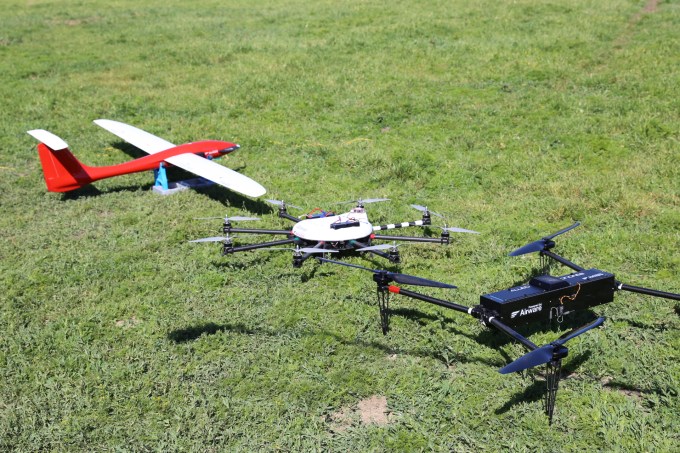
The benefit to customers like GE is clear. Plenty of companies need to inspect factories and pipelines, monitor farm land, and survey big tracts of land. Planes and helicopters can be terribly expensive for collecting this overhead video and measurement data, though. Meanwhile, sending humans around in trucks or dangling them in climbing harnesses can be slow and risky.
Drones are more than just war machines. Downey grew up the son of pilots, then built his own drones at MIT. Now his company Airware is going to teach them to do our bidding, and even save some lives.